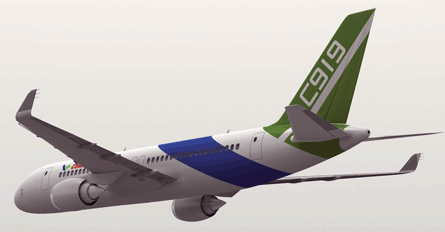At Asian Aerospace 2009, the state-owned Commercial Aircraft Corporation of China (Comac) made its international debut. Two years on, it is set to be the biggest exhibitor at this month's Asian Aerospace in Hong Kong.
The aircraft manufacturer is expected to garner a fair amount of attention, following last November's launch order for its C919 narrowbody jet announced at Airshow China in Zhuhai.
China's four major carriers Air China, China Eastern Airlines, China Southern Airlines and Hainan Airlines, as well as lessors CDB Leasing and GECAS, have placed orders for up to 100 C919s. Half of the 100 C919s are firm orders, with the remaining options, Comac's general manager Jin Zhuanglong has said.
 |
|---|
© ComacThe C919 is due to enter service in 2016 |
The aircraft, due to have its first flight in 2014 and enter service in 2016, is undergoing the joint definition phase. This was initially scheduled to be wrapped up in the first quarter of this year, but programme suppliers have indicated that this has been pushed back to summer. Comac has said it aims to conclude the detailed design phase in 2012.
At Airshow China last November, Comac revealed the aircraft's specifications. The jet will seat 168 passengers in an all-economy configuration or 156 in a mixed configuration. Comac plans up to six different variants for the twinjet, which will include a shrunken and stretched passenger version, freighter and business variants and a "special" variant, believed to be a military platform.
Since the airframer named the launch order for the C919, it has formally entered the process through which Chinese authorities will evaluate the development of the aircraft. In December 2010, the Civil Aviation Administration of China formally accepted Comac's application for a type certificate for the C919.
A team of CAAC officials in Shanghai will conduct the evaluation, Comac has said. Upon obtaining the certification, the airframer aims to apply for certification from US and European authorities through the CAAC with a view to marketing the aircraft overseas.
Comac is developing the C919 with help from major Western suppliers, which are carrying out the work in joint ventures with local Chinese partners. Unlike Comac's other in-development aircraft, the ARJ21 regional jet, which uses off-the-shelf components from Western suppliers, the C919 programme has made it necessary for Western suppliers to work with Chinese partners so that local companies can learn from established aerospace companies.
This requirement has not stopped major suppliers including and GE Aviation, Honeywell and Rockwell Collins from signing up. However, it remains to be seen if requiring suppliers to partner local companies will make or break the programme.
Teal Group analyst Richard Aboulafia has expressed concern that Comac's strategy with the C919 could work against it and result in an aircraft with little relevance outside the Chinese market.
"Western suppliers need to give away technology to play on this jet. It also means that this aircraft is designed by people whose hands have been tied," he says.
There is also concern that Western companies could be held back from bidding with their latest technology, due to fear over intellectual property rights. "If fearful Western suppliers bid last-generation equipment, it will wind up like the ARJ21. Like the C919, the ARJ21 regional jet was touted as proof that China would be the next big jet-maker. Instead, it has turned into an overweight and stunningly obsolete product that has no relevance outside China's tiny regional airline sector," says Aboulafia.
The ARJ21 programme has faced several delays. Comac had initially aimed for service entry in 2007, but first delivery has been postponed several times. It now aims to deliver the first ARJ21 by the end of this year to launch operator Chengdu Airlines.
While Aboulafia believes that the C919 will not go down the same road as the ARJ21, he cautions that Comac runs the risk of falling behind market leaders Airbus and Boeing when the jet eventually enters into service.
"In that case, the Chinese government will need to decide whether it wants healthy airlines that are free to buy what's on the world market, or a healthy national jetliner champion, prospering because the luckless local carriers are forced to buy an inferior jet," he says.
Source: Flight International



















